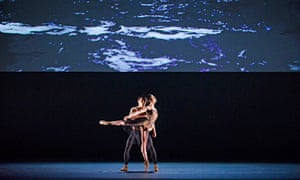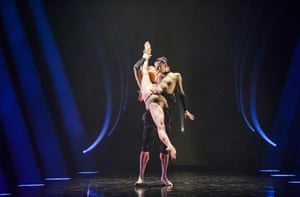

Um indescritível bailado na RTP2
Royal Ballet: Woolf Works review – a compellingly moving experience
Royal Opera House, London
Wayne McGregor’s ambitious triptych based on the multi-dimensional works of Virginia Woolf was a gamble that has paid off in exhilarating style
Wayne McGregor’s ambitious triptych based on the multi-dimensional works of Virginia Woolf was a gamble that has paid off in exhilarating style

When the final curtain fell on Wayne McGregor’s new ballet, Woolf Works, the cast were greeted with cheers and a standing ovation. And sighs of relief backstage, one imagines, because in more than one sense the Royal Ballet had bet the bank on the piece. If it had failed, it would have proved what many feared, and several expensive commissions had indicated: that the company famed worldwide for its story ballets could no longer tell a story.
The pressure was personal, too. McGregor was appointed resident choreographer at the Royal Ballet in 2006, following critical plaudits for his ballet Chroma. Infra(2008) and Limen (2009) completed a gleaming modernist triptych, but the works that followed, while attracting a fashionable crowd to the Royal Opera House, failed to convince many of the core ballet audience. Did McGregor represent a way forward for British classical dance or was he, as the New York Times suggested, “a cuckoo in the Royal Ballet nest”?
Rumours of a new McGregor ballet based on the works of Virginia Woolf began to circulate in 2014. It sounded like an odd project. How would McGregor’s high-stress choreography be brought to bear on this most patrician and complex of English writers? Would a Woolfian expert be involved? Not since Kenneth MacMillanstepped down in 1977 has a Royal Ballet director expressed a serious interest in literature. This wasn’t a concern while the bulk of the work commissioned was abstract, but with the recent resurgence of narrative ballets, the lack of in-house literary expertise has become a problem. Christopher Wheeldon’s Alice’s Adventures in Wonderland, McGregor’s Raven Girl and Liam Scarlett’s Sweet Violets and The Age of Anxiety are all, to a greater or lesser extent, compromised by narrative deficiencies.
So it was exhilarating, last Monday, to note the presence in the Woolf Works team of the writer and theatre director Uzma Hameed, and to read her crystalline analysis of the project’s intentions in the programme. The first of the work’s three sections (“I now, I then”) is inspired by Woolf’s 1925 novel Mrs Dalloway. Set to a commissioned score by Max Richter, the ballet shifts between the interior worlds of Clarissa Dalloway, a society hostess, and Septimus Warren Smith, a traumatised former soldier. The action moves backwards and forwards through time, with characters reflecting on the events that have led them to the present moment.

The sense of intersecting emotional dimensions, so characteristic of Woolf’s writing, is incisively realised. The role of Clarissa is shared by Alessandra Ferri and Beatriz Stix-Brunell. Ferri, a former Royal Ballet principal, is now 52 and her dancing – dark eyes, liquescent arms, quietly exquisite line – is heartrending. McGregor’s choreography for her has a fluttering, moth-like delicacy, which is quite unlike anything he has ever done.
Stix-Brunell, as Clarissa’s younger self, is also very fine, evincing a gentle restraint that doesn’t quite conceal her yearning sensuality. There’s a beautifully realised scene when Ferri’s Clarissa suddenly and impulsively kisses her friend, Sally (Francesca Hayward). When she recalls the event half a lifetime later, we realise from her expression that it’s the happiest moment she has ever known.
All of the characters are precisely evoked. Hayward’s Sally, neat as a Lalique figurine, darts and hovers with shimmering, dragonfly brilliance. Gary Avis is colourless to the point of near invisibility as Clarissa’s dull-dog husband, and Federico Bonelli deftly conveys the charm of the feckless Peter, her one-time suitor. Edward Watson, meanwhile, finds an eloquent pathos in the role of shell-shocked Septimus, tearing at himself as if to escape his own skin, and gazing wildly after the hallucinatory figure of his dead friend, Evans (Tristan Dyer).
In Woolf’s novel, Septimus and Clarissa never meet, but the ballet brings them together, each stalking the other as if haunted by a shared sense of what might have been. The impression of layered time and space is reinforced by Lucy Carter’s evanescent lighting, by Richter’s elegiac score and by the sets (free-floating, frame-like portals) designed by the architectural practice Ciguë. The result is as pitch-perfect in its restraint as it is true to its literary source.
Which makes the second section (“Becomings”), based on Woolf’s 1928 novel Orlando, all the more frustrating. The book is a fantastical tease, aimed at Woolf’s lover, Vita Sackville-West. Orlando, a poet, journeys through time from the Elizabethan era to the 20th century, turning into a woman en route. But McGregor deluges the sly gender games of the novel in a surfeit of Blade Runner-style effects. Lasers cut through drifting smoke, Richter’s score pounds and the choreography is frantic, studded with familiar McGregor tics. The piece conveys the hurtling velocity of the novel, but story and characterisation are lost, rendered into an abstract blur. Natalia Osipova comes and goes, her fabulously expressive talent expended in empty hyperextensions. Eric Underwood and Melissa Hamilton find calm in the storm, but there’s little here about Orlando, and less about Woolf.
In “Tuesday”, inspired by The Waves (1931), the ballet rediscovers its focus. The section opens with a reading of Woolf’s suicide note to her husband, written before she drowned herself in the river Ouse. The Waves is a stream-of-consciousness novel following the interior lives of six friends from childhood to adulthood. It’s a work replete with watery images, which Hameed and McGregor dissolve into a representation of Woolf’s last moments, as her life is replayed in a series of briefly flaring tableaux. Wave after wave of dancers takes the stage to Richter’s poignant score, breaking and swirling around the desolate figure of Ferri as the darkness enfolds her.
Woolf Works has its flaws. There’s that second section and the men’s costumes in “Tuesday”, which smack of the fetish club. But for the most part, the ballet is more than equal to its ambitions, with McGregor’s choreography illuminated, as never before, by Ferri’s refinement and Hameed’s scholarship. Together, they offer a compellingly moving experience and honour their subject.



Sem comentários:
Enviar um comentário